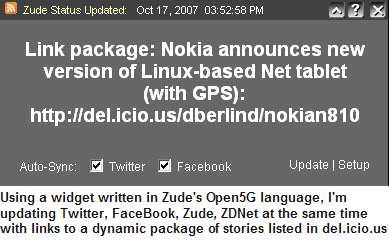Twitterizing mainstream media 102: The Zude to Facebook/Twitter to ZDNet to Del.icio.us connection

Back in August, I wrote about the Twitterization of mainstream media and how I'll bet that you'll see more of what I'm doing with Twitter from the mainstream media. Now, I'm taking it to the next level using Zude, Facebook and De.licio.us.

But, after forming the Twitter-to-ZDNet connection, I noticed the way Facebook allows you to follow all the changing status updates coming from your "friends." Facebook's "status" box isn't all that unlike what most people use Twitter for. In fact, by default, it starts with the word "is" underneath your first and last name (as in "XYZ Facebook User is....." and you fill in the blank). If you're a Facebook user, whatever you program into the blank after the "is" bubbles into the FaceBook user experience of anybody who has "friended" you. In some ways, it's just like Twitter which is why I was inspired to figure out how to pump my news summaries into yet a third place where people could be watching for my updates (place #1: Twitter, place #2: ZDNet, place #3: Facebook).
Enter Zude. Zude is unquestionably one of the killer sleepers of 2007. I've talked about it here in this blog. Robert Scoble liked it so much, he called it his Demo of the Year (and Scoble sees a lot of demos). One of the cool things about Zude is how you can pull all your points of social presence on the Web into a single page and then give the URL to that single page out so that your contacts don't have to go all over creation to experience your virtual persona. For example, if you go to the page in my Zudescape that I've entitled "David's Social Nets," not only will you a bunch of references to my ZDNet blog, my Flickr account, my Del.icio.us account, my Twitter feed, and my profile on Linked In, you should see how, by clicking on the down arrows on the right hand side of any one of those references how an entire, fully functional browser window opens right up, right inside of Zude (usually with no waiting). With the exception of how it can't include sites like Facebook that framebust HTML (technically it's possible, but legally?), it's really quite remarkable.
But, whereas Zude can be a Switzerland of the Social Web by acting as an aggregator of all your points of social presence (in other words, it can read them in), what about going the other way? To prove that it truly is a Switzerland, Zude CTO Steve Repetti used Zude's Open5G programming language to build a one stop widget that can update your status in Facebook and add a new tweet to Twitter with the same text. You can see the working version of this widget that I use on my main Zudescape page. Not only does it update both Facebook and Twitter at the same time, it updates itself as well which means I get to kill four birds with one stone. By entering a news item into the Zude "Status Widget," it shows up on Zude, Facebook, Twitter, and ZDNet.
But wait, there's more.
Most of the news items that I toss into that pipeline are ones that I pick up through my RSS subscriptions in Google Reader. One thing I've noticed when cruising all those RSS subscriptions is how you'll see lots of coverage of the same story from several sites and bloggers. For example, earlier this afternoon, I noticed how Dave Winer, InfoWorld, ZDNet, and Digg all had coverage of Nokia's newest N810 - a Linux-based Web tablet. Before today, I'd pick one of those and point to it (usually using TinyURL.com to shrink the length of the native URL) in a blurb that's 140 characters or less (Twitter's limit) that I publish via the aforementioned Zude widget. But why pick just one? Why not offer ZDNet's readers all four?
There are several ways I could do this, the most obvious is which to publish a separate string of text for each version of the story. But not only is that inelegant, it'd be way too verbose for anybody watching. So here's what I ended up doing. While discovering these items in Google Reader (my RSS reader), using the Firefox plug-in for Del.icio.us, I can right click on the permalink to any story and tag it right there. So, in this case, I right-clicked on all four of the aforementioned stories and tagged them in my del.icio.us account with the tag "nokian810". In del.icio.us, the resulting set of social bookmarks for that tag gets its own page: a page that I can point to natively or with via TinyURL (if the native del.icio.us URL is too long to fit in my text blurb). That way, when people want to find out more about what I've blurbed about, I'm not tying them to one point of view. I'm giving them all of the POVs I found.
But what's even better about this approach is that, if between the time I publish that blurb and the time you see it for the first time, another story about the Nokia N810 shows up in my RSS reader, I can tag that too so that by the time you get to my nokia810 page on del.icio.us, there are even more links there than when I first picked up on the news. If you see what I'm doing with Zude, Twitter, and Facebook as a twist on linkblogging, my inclusion of del.icio.us in the formula is more like dynamic linkblogging.